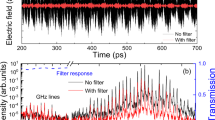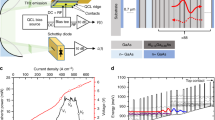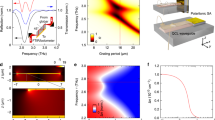Abstract
For future ultrafast all-optical networks, new optical devices are required that can directly manipulate communication channels and shift their wavelength over the bandwidth of an optical fibre (50 THz)1,2. Solutions based on nonlinear processes have been proposed, but these suffer from having only low efficiencies as a result of low nonlinear susceptibilities3. Here, we demonstrate all-optical wavelength conversion of a near-infrared beam using a resonant nonlinear process within a terahertz quantum cascade laser4. The process is based on injecting a low-power continuous-wave near-infrared beam in resonance with the interband transitions of the quantum cascade laser. This results in an enhanced nonlinearity that allows efficient generation of the difference and sum frequency, shifting the frequency of the near-infrared beam by the frequency of the quantum cascade laser. Efficiencies of 0.13% are demonstrated, which are equivalent to those obtained using free electron lasers. As well as having important implications in its application in ultrafast wavelength shifting, this work also opens up the possibility of efficiently upconverting terahertz radiation to the near-infrared and enables the study of high terahertz–optical field interactions with quantum structures using quantum cascade lasers.
This is a preview of subscription content, access via your institution
Access options
Subscribe to this journal
Receive 12 print issues and online access
$209.00 per year
only $17.42 per issue
Buy this article
- Purchase on Springer Link
- Instant access to full article PDF
Prices may be subject to local taxes which are calculated during checkout




Similar content being viewed by others
References
Eldada, L. Optical communication components. Rev. Sci. Instrum. 75, 575–593 (2004).
Desurvire, E. Capacity demand and technology challenges for lightwave systems in the next two decades. J. Lightwave Technol. 24, 4697–4710 (2006).
Campi, D. & Coriasso, C. Wavelength conversion technologies. Photon. Network Commun. 2, 85–95 (2000).
Köhler, R. et al. Terahertz semiconductor–heterostructure laser. Nature 417, 156–159 (2002).
DeCusatis, C., Maass, E., Clement, D. P. & Lasky, R. C. (eds) Handbook of Fiber Optic Data Communication (Academic Press, 1998).
Sirtori, C., Capasso, F., Faist, J., Pfeiffer, L. N. & West K. W. Far-infrared generation of doubly resonant difference frequency mixing in a coupled quantum well two dimensional electron gas system. Appl. Phys. Lett. 65, 445–447 (1994).
Belkin, M. A. Terahertz quantum-cascade-laser source based on intracavity difference-frequency generation. Nature Photon. 1, 288–292 (2007).
Kono, J. et al. Resonant terahertz optical sideband generation from confined magnetoexcitons. Phys. Rev. Lett. 79, 1758–1761 (1997).
Černe, J. Near-infrared sideband generation induced by intense far-infrared radiation in GaAs quantum wells. Appl. Phys. Lett. 70, 3543–3545 (1997).
Phillips, C., Su, M. Y., Sherwin, M. S., Ko, J. & Coldren, L. Generation of first-order terahertz optical sidebands in asymmetric coupled quantum wells. Appl. Phys. Lett. 75, 2728–2730 (1999).
Carter, S. G. et al. Terahertz-optical mixing in undoped and doped GaAs quantum wells: from excitonic to electronic intersubband transitions. Phys. Rev. B 72, 155309 (2005).
Ciulin, V., Carter, S. G., Sherwin, M. S., Huntington, A. & Coldren, L. A. Terahertz optical mixing in biased GaAs single quantum wells. Phys. Rev. B 70, 115312 (2004).
Su, M. Y., Carter, S. G., Sherwin, M. S., Huntington, A. & Coldren, L. A. Voltage-controlled wavelength conversion by terahertz electro-optic modulation in double quantum wells. Appl. Phys. Lett. 81, 1564–1566 (2002).
Wagner, M. et al. Resonant enhancement of second order sideband generation for intraexcitonic transitions in GaAs/AlGaAs multiple quantum wells. Appl. Phys. Lett. 94, 241105 (2009).
Carter, S. G. et al. Terahertz electro-optic wavelength conversion in GaAs quantum wells: improved efficiency and room-temperature operation. Appl. Phys. Lett. 84, 840–842 (2004).
Williams, B. S. Terahertz quantum cascade lasers. Nature Photon. 1, 517–525 (2007).
Dhillon, S. S. et al. Terahertz transfer onto a telecom optical carrier. Nature Photon. 1, 411–415 (2007).
Zervos, C. et al. Coherent near-infrared wavelength conversion in semiconductor quantum cascade lasers. Appl. Phys. Lett. 89, 183507 (2006).
Barbieri, S. et al. 2.9 THz quantum cascade lasers operating up to 70 K in continuous wave. Appl. Phys. Lett. 85, 1674–1676 (2004).
Rosencher, E. & Vinter B. Optoelectronics 2nd edn (Dunod, 2002).
Freeman, J. R., Brewer, A., Beere, H. E. & Ritchie, D. A. Photo-luminescence study of heterogeneous terahertz quantum cascade lasers. J. Appl. Phys. 110, 013103 (2011).
Vitiello, M. S. et al. Measurement of subband electronic temperatures and population inversion in THz quantum cascade lasers. Appl. Phys. Lett. 86, 111115 (2005).
Sutherland, R. L., McLean, D. G. & Kirkpatrick, S. Handbook of Nonlinear Optics (CRC Press, 2003).
Rosencher, E. & Bois, Ph. Model system for optical non-linearities: asymmetric quantum wells. Phys. Rev. B 44, 011315 (1991).
Yariv, A. Quantum Electronics 3rd edn (Wiley, 1989).
Blakemore, J. S. Semiconducting and other major properties of gallium arsenide, J. Appl. Phys. 53, R123–R181 (1982).
Garmire, E., Kost, A. & Khurgin, J. Nonlinear Optics in Semiconductors II (Academic Press, 1999).
Khurgin, J. Second-order nonlinear effects in asymmetric quantum-well structures. Phys. Rev. B 38, 4056–4066 (1988).
Scalari, G. THz and sub-THz quantum cascade lasers. Laser Photon. Rev. 3, 45–66 (2009).
Faist, J. Quantum cascade laser. Science 264, 553–556 (1994).
Shin, W., Han, S. W., Park, C. S. & Oh, K. All fiber optical inter-band router for broadband wavelength division multiplexing. Opt. Express. 12, 1815–1822 (2004).
Lu, Q. Y., Bai, Y., Bandyopadhyay, N., Slivken, S. & Razeghi, M. 2.4 W room temperature continuous wave operation of distributed feedback quantum cascade lasers. Appl. Phys. Lett. 98, 181106 (2011).
Acknowledgements
This work was financially supported by the Programme Francilien de Recherche en Nanosciences (CNano-IDF, contract TeraConversion) and the Agence Nationale de la Recherche (ANR, contract no. HI-TEQ ANR-09-NANO-017). J.R.F. acknowledges funding from the Marie Curie Action fellowship (grant no. 274602). J.M. acknowledges funding from the French Ministry of Defense (DGA). Laboratoire Pierre Aigrain (LPA) is a Unité Mixte de Recherche Associée à l'ENS, of the Centre National de la Recherche Scientifique (CNRS) UMR8551 and of Universités Paris 6 and 7. Device fabrication was performed at the nanocentre La Centrale de Technologie Universitaire (CTU-IEF-Minerve), which is partially funded by the Conseil General de l'Essonne.
Author information
Authors and Affiliations
Contributions
J.M. and P.C. set up the experiment, acquired the experimental data and contributed equally to the work. S.S.D. conceived the experimental concept. Photoluminescence measurements were taken by J.R.F., K.M. and P.C. Sample growth was performed by H.E.B. and D.A.R. The manuscript was written and the data interpreted by J.M., P.C., J.R.F., N.J., J.M., J.T., C.S. and S.S.D. C.S. provided insight and interpretation of the nonlinear properties of QCLs. All work was coordinated and overseen by J.T. and S.S.D.
Corresponding author
Ethics declarations
Competing interests
The authors declare no competing financial interests.
Supplementary information
Supplementary information
Supplementary information (PDF 724 kb)
Rights and permissions
About this article
Cite this article
Madéo, J., Cavalié, P., Freeman, J. et al. All-optical wavelength shifting in a semiconductor laser using resonant nonlinearities. Nature Photon 6, 519–524 (2012). https://doi.org/10.1038/nphoton.2012.157
Received:
Accepted:
Published:
Issue Date:
DOI: https://doi.org/10.1038/nphoton.2012.157
This article is cited by
-
Millimeter wave photonics with terahertz semiconductor lasers
Nature Communications (2021)
-
Highly efficient THz four-wave mixing in doped silicon
Light: Science & Applications (2021)
-
Wave engineering with THz quantum cascade lasers
Nature Photonics (2013)



